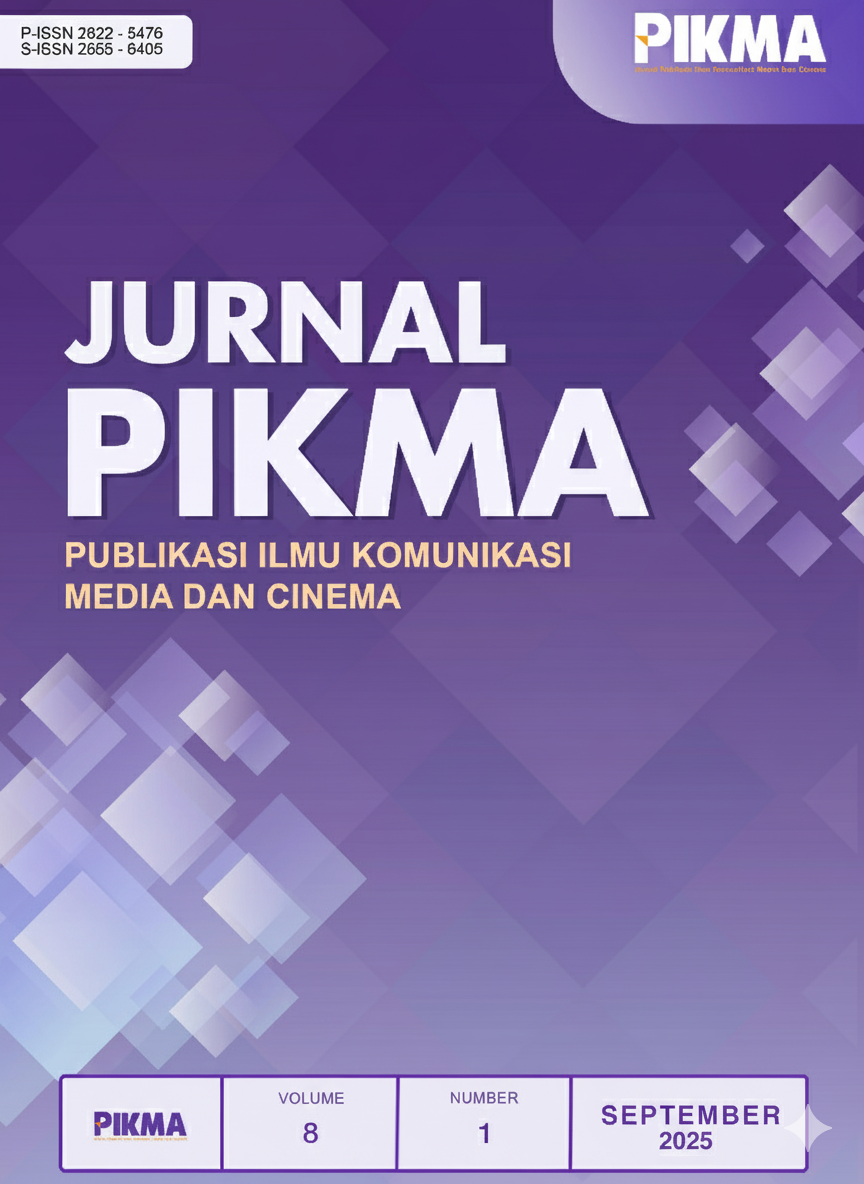The Self-Identity Construction of Virtual Idol Hatsune Miku Young Adult Fans
DOI:
https://doi.org/10.24076/rxwmcp72Keywords:
Digital Culture, Intercultural Communication, Pop Culture, , Virtual Idol, Self IdentityAbstract
This study examines the self-identity construction of young adult fans of the Japanese virtual idol Hatsune Miku using a qualitative cyber-phenomenology approach and Berger and Luckmann’s Social Construction of Reality theory. Data were collected through semi-structured in-depth interviews. Findings reveal that engagement with Hatsune Miku serves not only as entertainment but also as a source of emotional support, self-reflection, and affiliation within digital communities. Through processes of externalization, objectivation, and internalization, virtual interactions were found to shape a self-identity more closely connected to personal aspirations and social acceptance. All informants reported experiencing stigma linked to cultural stereotypes, such as being labeled wibu or “low nationalist,” which in turn fostered greater tolerance for cultural differences and acceptance of technological innovation. This study highlights the role of virtual idol engagement as a meaningful arena for identity formation and social adaptation in the digital era
References
About The Virtual Influencer. (2025). https://vocaloid.fandom.com/wiki/Hatsune_Miku on March 15, 2025.
Achenbach, T. M., Ivanova, M. Y., Rescorla, L. A., Turner, L. V., & Althoff, R. R. (2016). Internalizing/Externalizing Problems: Review and Recommendations for Clinical and Research Applications. Journal of the American Academy of Child & Adolescent Psychiatry, 55(8), 647–656. doi:10.1016/j.jaac.2016.05.012
Bailey, E. R., Matz, S. C., Youyou, W., & Iyengar, S. S. (2020). Authentic self-expression on social media is associated with greater subjective well-being. Nature Communications, 11(1). doi:10.1038/s41467-020-18539-w
Bastos, M. (2021). From global village to identity tribes: Context collapse and the darkest timeline. Media and Communication, 9(3), 27–38. doi:10.17645/mac.v9i3.3930
Berger, P. L., & Luckmann, T. (1967). The Social Construction of Reality: A Treatise in the Sociology of Knowledge. New York: Anchor Books.
Biber N., H., & P., L. (2011). The Practice of Qualitative Research (2nd ed.). US: SAGE.
Branje, S., de Moor, E. L., Spitzer, J., & Becht, A. I. (2021). Dynamics of Identity Development in Adolescence: A Decade in Review. Journal of Research on Adolescence, 31(4), 908–927. doi:10.1111/jora.12678
Bungin, B. (2021). Metodologi Penelitian Kualitatif (3rd ed.). Jakarta: Raja Grafindo Persada.
Bungin, B. (2023). Cyberphenomenology Research Procedure: Social Media, Big Data, dan Cybercommunity untuk Ilmu Sosial-Humaniora Kritik Terhadap Moustakas. Jakarta: Divisi Kencana.
Choi, S. J. (2020). Gender, Labor, and the Commodification of Intimacy in K-pop. University of California, California.
Creswell, J. W., & Poth, C. N. (2018). Qualitative inquiry and research design: Choosing among five approaches (4th ed.). New York: SAGE Publications.
Crypton Future Media. (n.d.). Hatsune Miku official website. .
Darfiyanti, Dita., & Ani Putra, B. (2012). Pemujaan terhadap Idola Pop sebagai Dasar Intimate Relationship pada Dewasa Awal: sebuah Studi Kasus. . Jurnal Psikologi Kepribadian Dan Sosial , 1(02).
Dharma, F. A. (2018). Konstruksi Realitas Sosial:Pemikiran Peter L. Berger Tentang Kenyataan Sosial. Kanal: Jurnal Ilmu Komunikasi, 7(1), 1–9. doi:10.21070/kanal.v6i2.101
Durante, M. (2017). The Informational Construction of the Self (pp. 83–99). doi:10.1007/978-94-024-1150-8_5
Epstein, Z., Hertzmann, A., Akten, M., Farid, H., Fjeld, J., Frank, M. R., … Smith, A. (2023). Art and the science of generative AI. Science, 380(6650), 1110–1111. doi:10.1126/science.adh4451
Erich Fromm. (1990). Man for himself; an inquiry into the psychology of ethics. . New York: Henry Holt and Company.
Fiedler, M. L., Wolf, E., Döllinger, N., Botsch, M., Latoschik, M. E., & Wienrich, C. (2023). Embodiment and Personalization for Self-Identification with Virtual Humans. 2023 IEEE Conference on Virtual Reality and 3D User Interfaces Abstracts and Workshops (VRW), 799–800. doi:10.1109/VRW58643.2023.00242
Fitzgerald, A. (2020). Professional identity: A concept analysis. Nursing Forum, 55(3), 447–472. doi:10.1111/nuf.12450
Fuchs, C. (2021). Social Media: a Critical Introduction. (3rd ed.). London: SAGE.
Gorea, M. (2021). Becoming Your “Authentic” Self: How Social Media Influences Youth’s Visual Transitions. Social Media and Society, 7(3). doi:10.1177/20563051211047875
Hanna, A. (2023). Review of Douglas Kellner (2021). Technology and Democracy: Toward a Critical Theory of Digital Technologies, Technopolitics, and Technocapitalism. Postdigital Science and Education, 5(1), 243–247. doi:10.1007/s42438-022-00309-0
Heaton, J. (2022). “*Pseudonyms Are Used Throughout”: A Footnote, Unpacked. Qualitative Inquiry, 28(1), 123–132. doi:10.1177/10778004211048379
Horowitz, M. J. (2012). Self-identity theory and research methods. Canada Journal of Research Practice Page 1 of 11 Journal of Research Practice (Vol. 8). AU Press. Retrieved from http://jrp.icaap.org/index.php/jrp/article/view/296/261
Huang, Q.-Q., Qu, H.-J., & Li, P. (2022). The Influence of Virtual Idol Characteristics on Consumers’ Clothing Purchase Intention. Sustainability, 14(14), 8964. doi:10.3390/su14148964
Downloads
Published
Issue
Section
License
Copyright (c) 2025 Jurnal PIKMA : Publikasi Ilmu Komunikasi Media Dan Cinema

This work is licensed under a Creative Commons Attribution-NonCommercial 4.0 International License.








